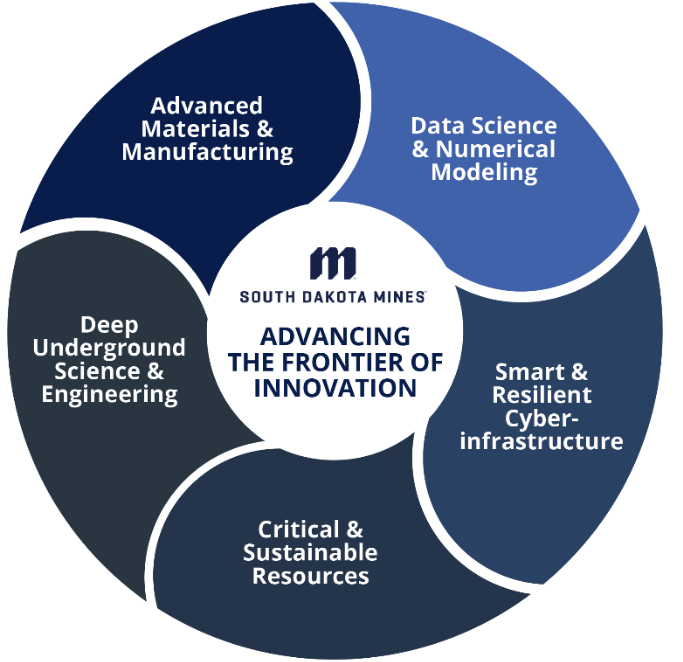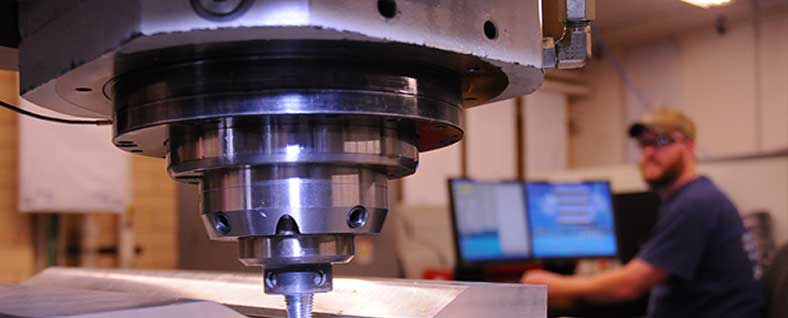Research & Innovation
At South Dakota Mines, research is deeply integrated into the academic fabric, encouraging students and faculty to explore, innovate, and solve real-world problems. The institution boasts a diverse array of university research facilities and centers. These facilities, along with departmental laboratories, provide state-of-the-art resources for groundbreaking research.
Collaboration is a cornerstone of Mines’ research philosophy. The university actively partners with industry, government agencies, and other academic institutions to drive forward impactful research initiatives. These collaborations enhance the scope of research conducted, ensuring that Mines remains at the forefront of technological advancement.
 Interdisciplinary research strengths at Mines include:
Interdisciplinary research strengths at Mines include:
- Advanced Materials & Manufacturing: Creating high-performance materials and efficient manufacturing processes.
- Deep Underground Science & Engineering: Exploring physics, geology, and engineering below the Earth’s surface.
- Critical & Sustainable Resources: Managing vital natural resources for modern technologies.
- Smart & Resilient Cyber-Infrastructure: Designing systems that ensure security, efficiency, and resilience.
- Data Science & Numerical Modeling: Using data for creative problem-solving solutions.
Additional Focus Areas
2025 Research Symposium
South Dakota Mines 15th annual Student Research Symposium will be held on April 8, 2025, in the Surbeck Center
2025 Abstract Booklet
(for updates on research, innovation, and economic development at Mines)
All funded research grants are managed through this office to promote efficient and effective submissions and administration of sponsored research and grants.
Applicant/Grantee/Awardee:
South Dakota School of Mines and Technology
501 E. St. Joseph Street
Rapid City, SD 57701-3995
Phone: 605-394-1218
Sponsored.Programs@sdsmt.edu
Authorized Official for all Proposals/Awards:
Laurie C. Anderson, PhD
Vice President for Research
Phone: 605-394-2493
Sponsored.Programs@sdsmt.edu
Department/Division:
Research Affairs/Sponsored Programs
Point of Contact:
Karmen Aga
Director, Office of Sponsored Programs
Phone: 605-394-1218
Karmen.Aga@sdsmt.edu
Cognizant Agency:
DHHS, Jeanette Lu, 415-437-7820
South Dakota Mines Identifiers:
Unique Entity Identifier: CJAJYT2KW771
Employer Identification Number (EIN)*: 466000364
Data Universal Numbering System (DUNS): 929928018
Congressional District: SD-001
NAICS Code: 611310
CAGE Number: 1BMV3
NSF Institutional Code: 0034702000
*EIN is equivalent to TIN (Taxpayer Identification Number) and to IRS number
Entrepreneurial work is highly encouraged at South Dakota Mines. Through the Innovation Cycle programming, students and faculty access resources that take their innovative ideas to commercialization or business startups.
Companies are encouraged to work with our tech transfer team on licensing available technologies.
The Office of Industry Engagement helps to connect businesses and organizations with the university, from classroom visits to research initiatives. Learn more.


